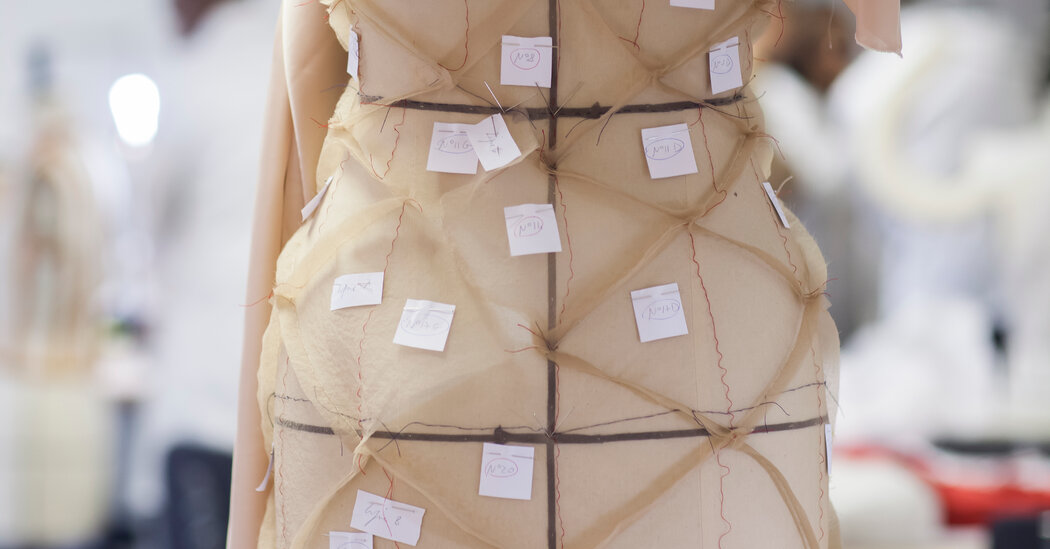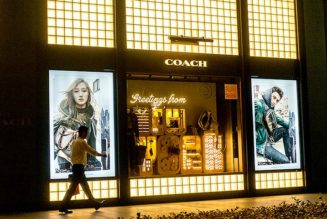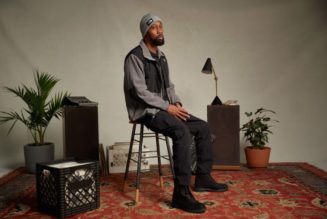
Renaissance, a French nonprofit, focuses on producing upcycled pieces made in the couture style while providing job training opportunities.
On a cold evening in March, a cement-floored warehouse in the gritty Paris suburb of Fontenay-sous-Bois played host to a different kind of couture fashion show. A model in a short-sleeved jacket with a bronze chevron bodice, navy silk chiffon kilt and swinging bronze chain fringe marched out to a D.J.’s club beat.
Another model wore a tangerine corset dress made of swirling strips of fabric that cascaded like a waterfall toward the floor. A third was dressed in a white silk strapless gown, gathered on the hip, that was embroidered with blue and pink posies.
Unlike traditional couture, as presented on runways in Paris this week, these clothes weren’t sewn by seasoned artisans or made from precious new materials. The bronze jacket was fashioned from a secondhand pair of Etro men’s pants and embroidered with thin chains from a company that had gone bankrupt.
The chiffon was dead stock from a retired couturière’s atelier. The tangerine dress was made from neckties of decommissioned uniforms of the Aéroports de Paris. The white floral gown had been a 19th-century shawl.
And all were sewn by a team of studio hands who, not long ago, would have had a difficult time finding jobs in the luxury fashion industry.
The event showcased the work of Renaissance, a French nonprofit that produces upcycled pieces made in the couture style and offers job training opportunities to low-income individuals and immigrants. It was founded in 2018 by Philippe Guilet, a former design assistant to Karl Lagerfeld, Thierry Mugler and Jean Paul Gaultier, who wanted to prove that couture could be more responsible.
The organization teaches some of the most sophisticated techniques in fashion design and builds on a movement by nonprofits to train workers and help place them in fashion jobs. Like much of traditional couture, many of Renaissance’s pieces are one-offs that are carefully handcrafted.
“There are other designers who work in upcycling, which is a solution for fashion waste,” said Pascal Morand, the executive president of Fédération de la Haute Couture et de la Mode, the governing body for the French fashion industry, and a member of the Renaissance board. There are organizations, he noted, that teach the craft of sewing. “But Renaissance combines these two aspects on a very high level,” he said.
Mr. Guilet, who had also worked for Chloé, J. Mendel and Donna Karan, had long been interested in upcycling. (For Mr. Gaultier’s spring 2002 couture collection, he made a cocktail dress out of men’s neckties.) He turned a pair of men’s pants into a waistcoat and showed it to Mr. Morand, a longtime friend. Mr. Morand thought the piece was beautiful and asked Mr. Guilet how he could spin it into something more.
Mr. Guilet decided he wanted “to do something that was eco-responsible that also passes on this beautiful savoir-faire,” he said, meaning an accomplished knowledge of craft.
He raised funding from the Kering luxury group and received grants from the French government. In September 2019, he opened an atelier in the Cité due Vercors, a public housing complex in Villejuif, a low-income suburb south of Paris. The space had been offered by Action Logement, an urban development association that helps fund and run social housing. There, Mr. Guilet set up sewing machines, work tables and Stockman dummies, and interviewed candidates sent by a government job placement agency.
He selected 15 people, including immigrants from Ghana, Morocco and Tunisia, and refugees from Ukraine and Afghanistan. Like all Renaissance students and teachers, they received wages and French employment benefits. For seven months, Mr. Guilet taught the class couture techniques, like the “Méthode Grès,” a fluid style of draping invented by the couturière Madame Grès.
“Couture is about the intelligence of the hand,” Mr. Guilet said. “If you understand couture, you can do anything. You are a master.”
Through word of mouth, Renaissance received donations of well-made vintage clothes, which the studio turned into modern silhouettes rooted in the French classics. Mr. Guilet staged the first Renaissance fashion show in March 2020, at the Institut du Monde Arabe.
The second collection, produced by the second class of 20 students, was presented at the Drouot auction house in Paris in July 2021. Afterward, some of the outfits from the first two shows were auctioned; several gowns sold for more than $7,000 apiece. Some of those pieces were displayed during couture week last January.
Though there are sewing machines in the Renaissance studio, much of the work is done by hand, as it is in couture. “This is not about cutting up old dresses and sewing them into something new, but about learning the couture technique,” Mr. Guilet said. “Students unpick the seams, and once it’s undone, they understand what they have, and figure out how best to use it with the aim of zero waste.”
During the course, each student produces two or three looks that are available for rent or purchase. Three looks ended up on the Netflix series “Emily in Paris,” including a sharply tailored suit made from a judo kimono given by the former champion of France; a dress refashioned from a Sonia Rykiel dress; and another dress cut from Yamamoto men’s pants and a Rykiel dress.
The organization’s job training program is also flourishing. Nearly half of Renaissance’s 35 graduates have landed jobs at luxury fashion houses, including Saint Laurent, Chloé, Alaïa and Dior, and several have opened their own studios, to produce wedding dresses, or do alterations and repairs.
Robby and Ted Kipre, 25-year-old twin brothers who grew up in the Cité du Vercors and were in the first class of apprentices, started a streetwear brand called Kipre Couture. They staged a show during Paris men’s fashion week in January, and they have held four pop-up shops in Paris.
During the post-show reception in the Fontenay warehouse in March, Ted Kipre said that fashion had “always been our passion — we always wanted to do it, but we didn’t know where to start.”
He was dressed in one of the brand’s looks: black crepe pants, a leather jacket and a Kipre Couture baseball cap — 100 percent upcycled, he said.
Renaissance is now developing a capsule collection produced by the current class of 40, selected from more than 1,300 applicants. The collection is made from uniforms donated by the RATP, the transportation agency in Paris that operates the Métro and buses. The clothes will be sold on Renaissance’s e-commerce website, which is scheduled to go live in September.
“Eventually, we’d like to have a boutique,” Mr. Guilet said. “Then anyone can bring in their beautiful old clothes and refashion them into something new.”









